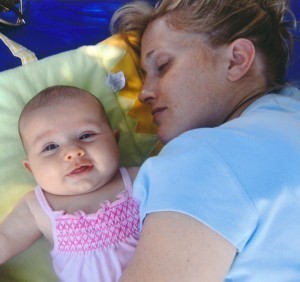Behind the Book
 For three months, I’d been faithfully taking my pre-natal vitamins, avoiding all unapproved foods and keeping my heart rate safely below 140 beats a minute. Yet, I didn’t really believe that my body would work—when called upon—the way health class had assured me it would. But there I stood in my squat, bathtub-less bathroom, a positive pregnancy test pinched in my already puffy fingers. And all I could think was: my God what have we done.
For three months, I’d been faithfully taking my pre-natal vitamins, avoiding all unapproved foods and keeping my heart rate safely below 140 beats a minute. Yet, I didn’t really believe that my body would work—when called upon—the way health class had assured me it would. But there I stood in my squat, bathtub-less bathroom, a positive pregnancy test pinched in my already puffy fingers. And all I could think was: my God what have we done.
Once I got over the initial shock of being pregnant, I convinced myself that I would figure it out. I’d always been a quick study, and I wasn’t afraid of a little hard work. I’d been a lawyer and a writer and had traveled all over the world. I’d climbed a mountain and run a marathon. I’d learned to speak Japanese and taught myself to bake. If I could do all those things, then surely with enough time and effort, I could learn to properly care for a child. Surely.
And I did, eventually. I learned to care for two, in fact. I consulted books and wise friends and doctors, but mostly it was trial and error. It certainly has not been easy. There have been countless sleepless nights and voluminous tears—theirs and mine. So far, we have survived endless colic and reflux and trips to the ER for stitches. We’ve held our breath through first steps and first days of school and first best friends. I’ve changed countless diapers, bandaged endless scraped knees, assessed the severity of numerous head wounds and have been thrown up on more than I ever would have thought possible.
Of course, the physical demands—aggravating and exhausting though they sometimes may be—are actually the easy part. It’s being a mother that’s so very hard. Just the idea of being that person, to another living being, forever, gives me vertigo. And then there are the actual responsibilities being someone’s mother entails. I’m supposed to help my children grow into happy people. But what makes a person happy? Success, love, freedom? If I’m still trying to figure that out, how can I possibly teach my daughters? What am I to do when their fears terrify me? How can I make them feel loved unconditionally and completely in those dark moments when I’m not sure I like them very much?
And how on earth—in a world so filled with dangers, big and small—will I ever keep them safe?
More than once, I’ve turned a corner on the way to pick up one of my children and seen an ambulance parked in front of one of their schools. Or at least that’s the way it looks, from several blocks away, down a busy Brooklyn avenue. Every time, I tell myself that my child has not accidentally eaten one of those cashews that she is so allergic to or fallen off the monkey bars or choked on a carrot. No, my child is fine.
And yet, I always walk a little faster, eyes locked on the ambulance, until I can confirm that it’s actually just parked, off-duty. Perhaps, I worry because I’m especially fatalistic. But I don’t think so. I think I worry because, deep down, I know the truth: that there is only so much I can do to protect my girls.
My novel is told from the alternating perspectives of both Amelia and her mother Kate, to show how children—no matter how well-adjusted, no matter how well-loved—can be so easily singled out for abuse and suffer its inevitably heartbreaking consequences. Reconstructing Amelia explores how our children can get so terribly lost, despite the fact that we’re trying our best to keep them found.



